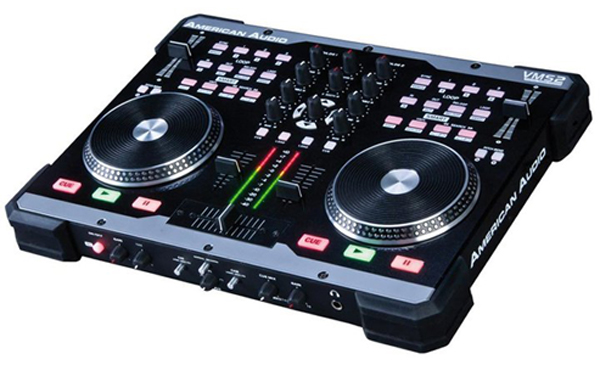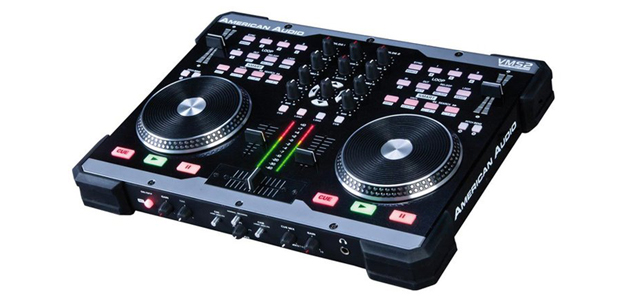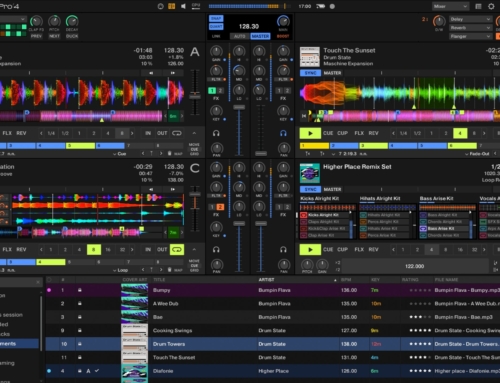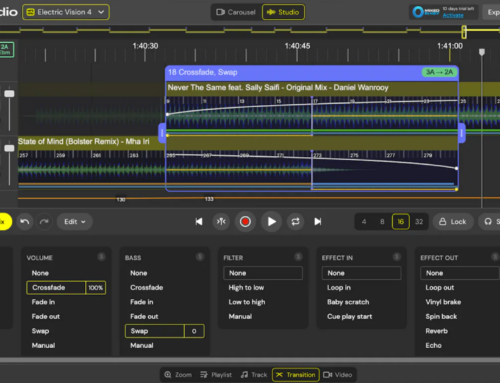
American Audio VMS2 2-Channel Midi Controller
Following on the success of the VMS4, American Audio recently released the all-new VMS2 combination mixer and MIDI controller. Like its 4-channel predecessor, which I reviewed two months ago, the VMS2 has a fully computer-independent mixer section that can be used to juggle two analog audio sources, PC audio, or a combination of the two. The VMS2 also has a wealth of knobs and buttons to control a variety of DJ programs via MIDI. Though strikingly similar in appearance to the VMS4, I found that two channels weren’t the only features lost in the process of downsizing.
The first thing I noticed when I looked at the VMS2 was its lack of a dedicated effects section. As a complete FX junkie, this was initially quite traumatizing. The looping section and six of the eight cue triggers were retained, so the omission of effect control just leaves me wanting. Though new MIDI maps and control schemes can inevitably add this functionality (just like my favorite VMS4 map gives the unit control of all four effects decks instead of just two), the inability to control effects easily and intuitively right out of the box and without modification is a big disadvantage.
 A new addition to the mixer, however, is a navigation section that allows you to navigate your music library from within your favorite DJ program. That is a truly great inclusion, because I can remember lamenting the lack of quick and easy browser navigation when I first received my VMS4. This navigation section also feels much better than the controls found on competing mixers, though perhaps that’s just because the buttons and knobs just feel great on the VMS2 in general.
A new addition to the mixer, however, is a navigation section that allows you to navigate your music library from within your favorite DJ program. That is a truly great inclusion, because I can remember lamenting the lack of quick and easy browser navigation when I first received my VMS4. This navigation section also feels much better than the controls found on competing mixers, though perhaps that’s just because the buttons and knobs just feel great on the VMS2 in general.
The VMS2 feels just as satisfyingly robust as its older brother – it has the same metal casing, the same rubberized corners, the same quality faders, and the same rubber knobs as the VMS4, all adding together to make a true tactile delight. The jog wheels are also very similarly sturdy, but I found them to be much better at controlling Traktor than the jog wheels on the VMS4, which was a pleasant surprise. While I wouldn’t recommend replacing your SL-1200s with a brand new VMS2, I am at least willing to say that the improved jog wheels make scratching in Traktor a possibility.
Because it is rather incongruous to expect any professional level of scratch control from MIDI controller jog wheels, it makes little sense to me that American Audio went out of the way to make the VMS2 “Innofader compatible” so that DJs can swap out the stock fader for something made to assist in heavy and frequent scratch DJing. Some of the other special features included have potential, such as the built in DSP D-Core, which is supposed to increase the sound quality of audio and especially microphone output. It was hard to discern any real difference in the output of either analog or PC audio, but I must admit the mic audio did sound much better.

The VMS2 has been charged with a weighty task: suffer a decrease in both size and capability compared to the much more robust VMS4 while simultaneously upgrading the components contained within. Overall, I’d say American Audio did a pretty good job on this one. While the lack of a dedicated effects section makes me quite forlorn, that may just be a matter of taste. The fact is that what American Audio has produced is a really versatile 2-channel mixer with complex MIDI control over track transport, and it serves that purpose really well. The rugged construction, powerful sound card, and Midilog mixer section of the VMS2, like those of its big brother the VMS4, combine to make this unit a force to be reckoned with among today’s 2-channel mixer/controllers.
For a more complete review, please check out my review of the American Audio VMS4, which can be found here. Many features are nearly identical between the units, and this article has mostly focused on the things that are different.




